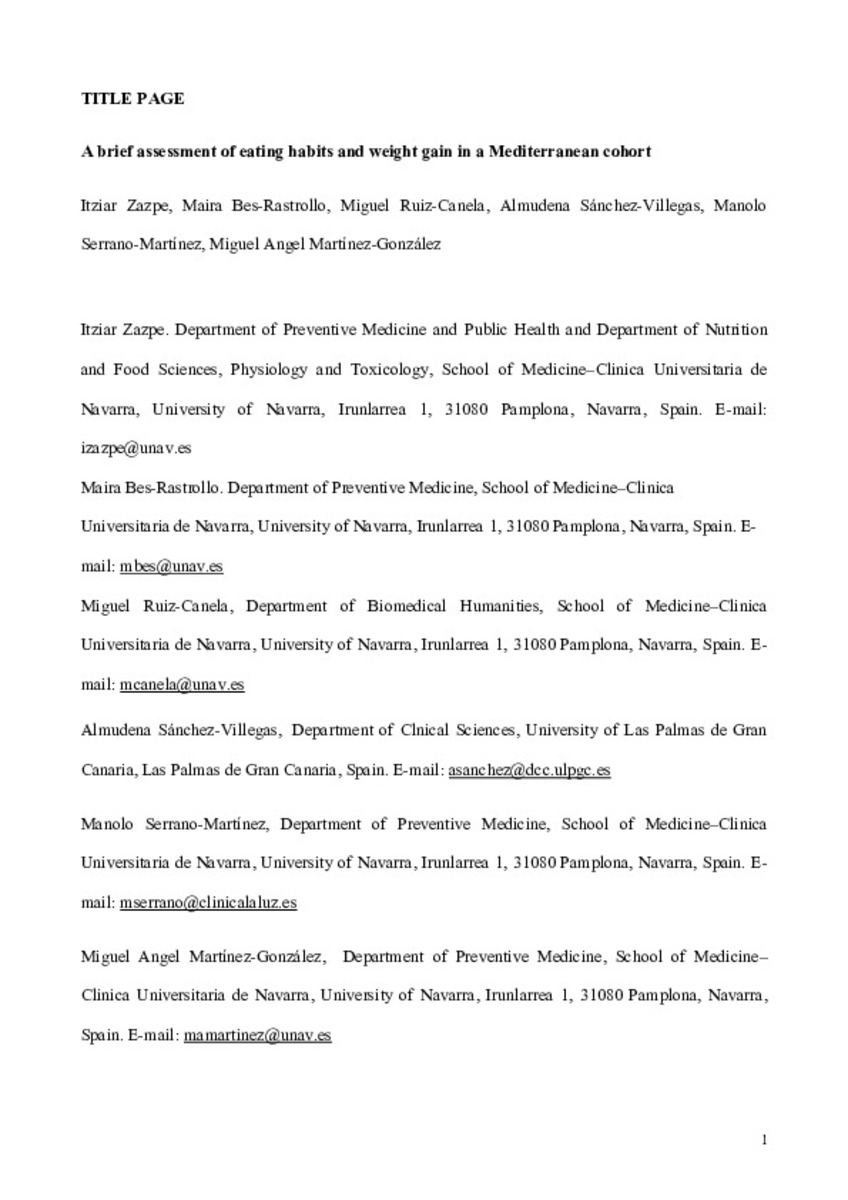Full metadata record
| DC Field | Value | Language |
|---|---|---|
| dc.creator | Zazpe, I. (Itziar) | - |
| dc.creator | Bes-Rastrollo, M. (Maira) | - |
| dc.creator | Ruiz-Canela, M. (Miguel) | - |
| dc.creator | Sanchez-Villegas, A. (Almudena) | - |
| dc.creator | Serrano, M. (Manuel) | - |
| dc.creator | Martinez-Gonzalez, M.A. (Miguel Ángel) | - |
| dc.date.accessioned | 2011-03-28T11:45:53Z | - |
| dc.date.available | 2011-03-28T11:45:53Z | - |
| dc.date.issued | 2010 | - |
| dc.identifier.citation | Zazpe I, Bes-Rastrollo M, Ruiz-Canela M, Sanchez-Villegas A, Serrano-Martinez M, Angel Martinez-Gonzalez M. A brief assessment of eating habits and weight gain in a Mediterranean cohort. Br J Nutr 2011 Mar;105(5):765-775. | es_ES |
| dc.identifier.issn | 0007-1145 | - |
| dc.identifier.uri | https://hdl.handle.net/10171/17243 | - |
| dc.description.abstract | Assessment of eating habits (EH) through closed questions could be an alternative tool to assess diet as a predictor of weight change in epidemiological studies. The aim was to assess the association between baseline EH and risk of weight gain or becoming overweight/obese in a Spanish dynamic prospective cohort (the SUN Project) of 10,509 participants. The baseline questionnaire included 10 short questions with two possible answers: Yes or No. We calculated a baseline EH score, categorized in quartiles, positively weighting answers on more fruit, vegetable, fish and fiber and less meat, sweets and pastries, fat, butter, fatty meats and added sugar to drinks. Reducing the consumption of meat or fat and removing fat from meat were significantly associated with lower weight gain. Partial correlation coefficient between EH score and weight change was -0.033 (p=0.001). We observed 1063 cases of incident overweight/obesity among 7217 participants without overweight/obesity at baseline. Trying to eat more fruit, fish, or fiber and less meat were inversely significantly associated with incident overweight/obesity. Those participants in the upper quartile of the score were at 38% (adjusted OR: 0.62; 95% CI: 0.48-0.81) lower risk of developing overweigh/obesity during follow-up compared to those in the lower quartile. However, the ROC curves for the model with and without the EH score were materially identical. Despite the apparent significant inverse association, this score had a low predictive value for future weight gain and for incident overweight/obesity in a Mediterranean population, although some EH were independently and positively associated with weight gain. | es_ES |
| dc.language.iso | eng | es_ES |
| dc.publisher | Cambridge University Press | es_ES |
| dc.rights | info:eu-repo/semantics/openAccess | es_ES |
| dc.subject | Materias Investigacion::Ciencias de la Salud | es_ES |
| dc.subject | Obesity | es_ES |
| dc.subject | Cohort studies | es_ES |
| dc.subject | Prospective study | es_ES |
| dc.subject | Food frecuency questionnaire | es_ES |
| dc.title | A brief assessment of eating habits and weight gain in a Mediterranean cohort | es_ES |
| dc.type | info:eu-repo/semantics/article | es_ES |
| dc.relation.publisherversion | http://journals.cambridge.org/action/displayJournal?jid=BJN | es_ES |
Files in This Item:
Statistics and impact
Items in Dadun are protected by copyright, with all rights reserved, unless otherwise indicated.






